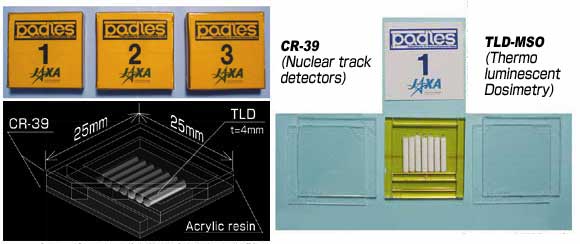This is an archive of information released in the past.
Disclaimer: It may contain broken links or outdated information. Some parts may not function in current web browsers.
*Visit https://humans-in-space.jaxa.jp/en/ for the latest information.

Experiment
- News
- Kibo Utilization Strategy
- Kibo Utilization Plan
- List of JAXA's Utilization Themes
- Experiment Facilities
- Space Environment Utilization
- Archive
PAssive Dosimeter for Life science Experiments in Space (PADLES)
Passive dosimeter packages and an analysis system are developed by JAXA for supporting life science experiments. They provide environmental data for space radiation. In the ISS, we are planning to measure space radiation by a combination of Nuclear track detectors and Thermoluminescent Dosimetry. TLD are used for estimating an absorbed dose for space radiation in the LET region below 10 keV/µm. CR-39 plastic plates are used for measuring LET distributions of heavy-charged particles in the LET region above 10 keV/µm. We estimate the absorbed dose and dose equivalent above 10 keV/µm from the LET distributions.
- PADLES is a compact and battery-less Dosimeter, having the advantage of no necessity of crew times and package for setting extremely close to biological samples. (The basic PADLES external form: 2.5 cm x 2.5 cm x 0.4cm)
- The dosimeters will be adjacent to biological samples on board at all times. It is available to use at storage temperatures from -80 deg. C to +37deg. C.

| Detectors | Measurements | Particles/ Characteristics |
LET range (keV/fÊm) |
|
| TLD | MSO-S | Absorbed dose*1 | Photons, Charged particles |
0.2 - 10 |
| CR-39 | HARZLAS(TD-1/TNF-1) | LET spectrum | Charged particles | 2 - 1000 |
| BARYOTRK/HARZLAS(TD-1) | particle tracking | HZE*3 particles | > 40 *4 | |
| TLD | MSO-S | Absorbed Dose | Photons, Charged particles |
0.2 - 1000 |
| CR-39 | HARZLAS(TD-1/TNF-1) | Equivalent Dose*1 | Photons, Charged particles |
|
| Effective Quality Factor*2 | Photons, Charged particles |
|||
| Temperature | -80 - +40 deg. C | |||
| Gas | 1atm, the air | |||
| Package Size | 25mmW*25mmL*4mmt typical | |||
| On Board Period | a standard period: 3 month (minimum:1 week - maximum :1 year) | |||
| *1Integral flux on board period *2an average on board period *3High-atomic-number (Z) and high-energy (E) charged particles. *4It's suitable for charged particles having high atomic number more than Si ion. |
||||
- See also:
- Free-Space PADLES
- PADLES database
- H. Tawara, S. Kamigaichi, M. Masukawa, A. Nagamatsu, T. Nakano, H. Kumagai, M. Masaki, E.Kurano, H. Yasuda, N. Yasuda, : Development of techniques for space-radiation dosimetry using passive detectors, Ionizing Radiation, Vol.27, No.4, 29-41(2001) (in Japanese).
- H. Tawara, M. Masukawa, A. Nagamatsu, : Space-radiation disimetry using CR-39
and TLD integrationg dosimeters, , Ionizing Radiation, Vol.28, No.2, 181-194 (2002) (in Japanese). - A. Nagamatsu, M. Masukawa, S. Kamigaichi, H. Kumagai, M. Masaki, N. Yasuda, H. Yasuda, E. Benton, T. Hayashi, H. Tawara:Development of the space radiation dosimetry system ‘PADLES、RADIATION DETECTORS AND THEIR USES 2006-7, p26-36 (2006).
| Copyright 2007 Japan Aerospace Exploration Agency | Site Policy |